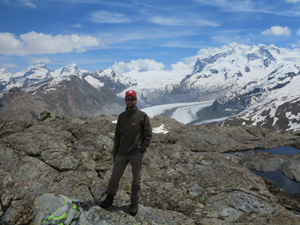Mechanically- v. Diffusion-Controlled Metamorphic Microstructure: A Symplectite Example from Rhodope Metamorphic Complex (Greece).
- Journal of Metamorphic Geology 33 (8): 849-58. doi:10.1111/jmg.12141
Abstract
Gradients in chemical potential are the driving force for chemical diffusion and their spatial distribution is thus essential to investigate equilibrium in metamorphic rocks. At high temperatures (>650 °C), where chemical diffusion is relatively fast, the development and preservation of compositional zoning in minerals can be controlled by mechanically maintained pressure variations. Therefore, the dependence of chemical potentials on pressure plays an important role in correct interpretations of rock microstructures. Distinguishing between pressure-controlled chemical zoning and zoning reflecting chemical diffusion is a challenge. To tackle this challenge, we investigate a symplectitic microstructure around kyanite in an amphibolitized eclogite from the Rhodope Metamorphic Complex (Greece). The sample recrystallized at high temperatures (~720 °C) and low pressures (<1 GPa) during which kyanite was replaced by fine-grained symplectites of sapphirine, spinel, plagioclase and corundum. The plagioclase rim around kyanite shows a cusp-shaped chemical zoning of calcium along the grain boundaries. The results from combined phase equilibria and diffusion modelling show that the cusp-like shapes were developed by fast grain boundary diffusion at constant pressure after the relaxation of grain-scale pressure variations across the plagioclase rim. The results illustrate an example where petrographic observations help to distinguish between mechanically- and diffusion-controlled chemical zoning.
Mineralogical reactions which generate or consume fluids play a key role during fluid flow in porous media. Such reactions are linked to changes in density, porosity, permeability, and fluid pressure which influence fluid flow and rock deformation. To understand such a coupled system, equations were derived from mass conservation and local thermodynamic equilibrium. The presented mass conservative modeling approach describes the relationships among evolving fluid pressure, porosity, fluid and solid density, and devolatilization reactions in multicomponent systems with solid solutions. This first step serves as a framework for future models including aqueous speciation and transport. The complexity of univariant and multivariant reactions is treated by calculating lookup tables from thermodynamic equilibrium calculations. Simplified cases were also investigated to understand previously studied formulations. For nondeforming systems or systems divided into phases of constant density, the equations can be reduced to porosity wave equations with addition of a reactive term taking the volume change of reaction into account. For closed systems, an expression for the volume change of reaction and the associated pressure increase can be obtained. The key equations were solved numerically for the case of devolatilization of three different rock types that may enter a subduction zone. Reactions with positive Clapeyron slope lead to an increase in porosity and permeability with decreasing fluid pressure resulting in sharp fluid pressure gradients around a negative pressure anomaly. The opposite trend is obtained for reactions having a negative Clapeyron slope during which sharp fluid pressure gradients were only generated around a positive pressure anomaly. Coupling of reaction with elastic deformation induces a more efficient fluid flow for reactions with negative Clapeyron slope than for reactions with positive Clapeyron slope.
